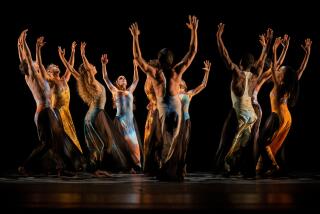Obituary : Alvin Ailey Jr., 58; Founder of Famed Modern Dance Company
Alvin Ailey Jr., founder of the internationally renowned modern dance company that bears his name, died Friday in a New York City hospital of a blood disorder, said a spokeswoman for the dance company. He was 58.
Ailey, who died about 4:55 p.m. at Lennox Hill Hospital, had been suffering from the disease for a year, spokeswoman Meg Gordean said. Lenox Hill officials refused to give details about the illness.
“He was clearly one of the giants of modern dance,” said Michael Wright, executive director of the Erick Hawkins Dance Company and one of Ailey’s longtime colleagues. “But he also did more for American blacks and American black culture in dance than any other person that I know of.”
The choreographer, who assembled the Alvin Ailey American Dance Theatre in 1958, had earned worldwide fame for his company’s spectacular blend of the American modern dance tradition and such African-American musical expressions as jazz, blues and spirituals.
Ailey, whose troupe swelled from the original seven members to the current 28, had retired from performing in 1968 to concentrate on choreography.
Although his works were at times criticized as excessively showy, Ailey built a company that gave black dancers an unprecedented chance at professional dance careers and helped bring other multicultural choreographers to prominence by programming their works. In addition, he sparked interest among mainstream audiences in the overlapping traditions that form the black experience in America.
In all, he created 79 ballets.
“Ailey was a pioneer who managed to fuse modern dance, showbiz dance and an original vision of the black experience in American life,” said Martin Bernheimer, music and dance critic for The Times. “He broke down many racial barriers. . . . His importance wasn’t as a dancer but as a choreographer and as a dancer.”
In addition to creating works for his own company, Ailey’s ballets have appeared in the works of other companies including the American Ballet Theatre, The Joffrey Ballet, the Paris Opera Ballet, the London Festival Ballet, and the Royal Danish Ballet.
“One must also wonder what we’ll never see and what dances may never be danced because of the loss,” said Jeremey Alliger, executive director of the Dance Umbrella in Boston. “Alvin Ailey has served as a role model for all of us working in the field.”
Born in Rogers, Tex., in 1931, Ailey was the sole child of Alvin and Lula E. Ailey. After his parents separated, Ailey moved to Los Angeles in 1942 with his mother.
There, he fell in love with the style of modern dance master Lester Horton, with its radical mix of dance and theatrics. Although Ailey performed regularly with the Lester Horton Dance Theatre, he continually wavered between dance and teaching as professions.
After graduating from Thomas Jefferson High School in 1948 and Los Angeles City College three years later, Ailey left the company to study Romance languages at San Francisco State College.
But when Ailey began dancing in a nightclub act in San Francisco in 1953, his irresolution over career choices ended. Alvin Ailey wed himself to dance for life.
He rejoined the Lester Horton Dance Theatre and remained with the company for a year after Horton’s death in 1953.
He choreographed Darius Milhaud’s “Creation of the World” for a performance by a Horton company and the San Diego Symphony. He also danced in the film “Carmen Jones,” which was later released by 20th-Century Fox.
Ailey left the Horton company for New York City in 1954 to perform in a Broadway production of Truman Capote’s “House of Flowers.”
During his first years in New York, Ailey studied dance with such greats as Martha Graham, Hanya Holm and Charles Weidman.
On March 30, 1958, Ailey and friend Ernest Parham recruited a team of dancers and presented their first independent production in the Theresa Kaufmann auditorium. The works--Ode and Homage (a memorial to Lester Horton), Blues Suite and five dances on Latin themes--drew critical acclaim.
“As a dancer, Mr. Ailey is exceptional,” wrote Dance magazine’s Doris Hering in May, 1958. “He reminds one of a caged lion full of lashing power that he can contain or release at will.”
The Alvin Ailey Dance Theatre performed full-scale concerts for the first time in December of 1958, the program including ballets set to the music of Debussy.
Audiences found “the stage world created by Alvin Ailey an altogether stimulating, exciting, beautiful, funny and original entertainment, meticulously presented,” wrote critic P.W. Manchester in a 1959 edition of the Dance News.
Two years after the theater’s debut, Ailey produced “Revelations,” commonly regarded as the greatest of his works. The program note described “Revelations” as an exploration of “motivations and emotions of American Negro religious music.”
A biography of Ailey notes that “no Alvin Ailey Dance Theatre Program is considered complete without (“Revelations”).”
For the next few years, Ailey’s company performed concerts throughout the nation. In 1962, the troupe spent 13 weeks traveling the Far East in a tour sponsored by the State Department, becoming the first African-American dance company to perform in Southeast Asia. The group presented a portion of Ailey’s repertoire of African-American folk dances as well as “Mountain Way Chant,” based on Navajo Indian rites.
The tour established the group’s universal appeal and sparked the series of international shows that would follow.
Ailey’s company toured the world over the next two decades, performing works ranging from Ailey’s “Labyrinth,” based on the myth of Theseus and the Minotaur, to “Memoria.”
In the 1970s, some members of the African-American communities pressured Ailey to remove non-black dancers from his troupe. Ailey, however, stood his ground.
“Yes, there were some phone calls and some inferences,” he said in an interview with the New York Times. “But we were just coming together as a people through the civil rights period. I felt that people were people and that a black theme expressed by dancers of all colors would be enlarged. It became a universal statement.”
Ailey also said of his work: “I am trying to show the world we are all human beings, that color is not important, that what is important is the quality of our work.”
Ailey is survived by his mother, Lula Cooper; his step-father, Fredrick W. Cooper; and a half-brother, Calvin Walls Cooper.
Funeral arrangements are incomplete.
More to Read
The biggest entertainment stories
Get our big stories about Hollywood, film, television, music, arts, culture and more right in your inbox as soon as they publish.
You may occasionally receive promotional content from the Los Angeles Times.









